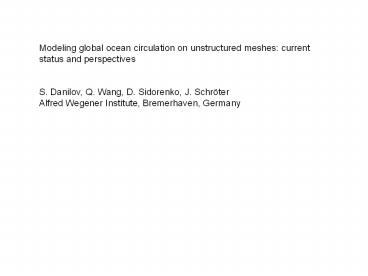Modeling global ocean circulation on unstructured meshes: current - PowerPoint PPT Presentation
1 / 13
Title:
Modeling global ocean circulation on unstructured meshes: current
Description:
Modeling global ocean circulation on unstructured meshes: current status and perspectives S. Danilov, Q. Wang, D. Sidorenko, J. Schr ter Alfred Wegener Institute ... – PowerPoint PPT presentation
Number of Views:102
Avg rating:3.0/5.0
Title: Modeling global ocean circulation on unstructured meshes: current
1
Modeling global ocean circulation on unstructured
meshes current status and perspectives S.
Danilov, Q. Wang, D. Sidorenko, J.
Schröter Alfred Wegener Institute, Bremerhaven,
Germany
2
Goal Modelling large-scale ocean
circulation Main motivation Representation of
coastlines, straits, or need to resolve
local processes will benefit
from using variable
resolution Existing models ADCIRC, TELEMAC,
FVCOM, UnTRIM, ...
main area coastal oceanography
FEOM/FESOM
(AWI) large-scale circulation
SLIM (University Louvain la Neuve),
ICOM (Imperial) As a rule the complex shape of
ocean basin requires to invest degrees of freedom
in geometry gt low-order elements are used
3
What we have already tried in FEOM P1-P1
version (3D primitive equations) Current
versions prismatic and tetrahedral
P1-P1 Prismatic more symmetric
vertical stencil quadratures on
generalized meshes (slow) Tetrahedra
implementation of generalized vertical
coordinate is straightforward inclined vertical
stencil
4
Main features Pressure(elevation) correction
method (no barotropic velocity) Explicit (where
possible) TG, FCT (TG-based) and GLS-stabilized
advection schemes. Nonlinear free surface and
nonhydrostatic options MPI parallelized, coupled
to sea ice, realistic forcing (CORE) Examples
D. Sidorenko talk Main difficulties Implicit
vertical viscosity/diffusion is slow because of
horizontal connections in CG Slope noise in GM
in tetrahedral discretization Difficult to keep
pressure and vertical velocity fully
consistent In hydrostatic finite-element
codes elevation, w, tracers, and pressure should
have the same horizontal discretization. w,
pressure and density - same vertical
discretization gt Consistent w/p solution is
difficult to obtain with CG tracers! CPU time
prismatic and tetrahedral codes behave very
similar Despite 3 times larger amount of
elements each of them is less CPU-expensive.
5
Q. Wang
6
Ross Sea overflow, simulations by Q. Wang.
Resolution 0.5 km 30 km
7
Assimilation of ice drift velocities in a
regional finite element sea ice-ocean model
(SEIK filter)
Beobachtung
Assimilation
Modell
Drift fields derived from passivemicrowave
satellite data
R.Timmermann,K. Rollenhagen
8
P1nc-P1 branch Pressure correction method
(without stabilization). Tracer part inherited
from FEOM Advantages no stabilization Diagonal
mass matrix for velocity (on z-meshes)
. Difficulty momentum advection (P1
re-projection is much more robust than
true P1nc) Intercomparison between P1-P1 P1nc-P1
versions of FEOM and MITgcm suggests that NC
version is marginally faster (about 10) FEOM is
about 10 times slower than MITgcm
Kinetic energy evolution in a baroclinically
unstable channel flow
Temperature distribution in 1/6 degree, 16 layers
channel after 3 years of evolution (100 m)
9
P1nc-P1 further developments Lon-lat free
version (following ideas of Louvain
group) Velocity P0 in vertical (more consistent
boundary conditions
on z-coordinate meshes)
CPU speed remains our major difficulty as our
typical applications require weeks to be
completed on available resources (64-256 cores).
FV technologies have to be explored.
10
FV type of discretization (an analog of P0-P1
velocity vector at centroids, scalar fields at
nodes) Although scalar control volumes (dual
median) look ugly, assembling RHSs is fast using
the edge-based structure. Pressure
(elevation) correction (semi-implicit), AB2
Coriolis, Implicit vertical diffusion, z-levels.
Momentum and tracer advection is second-order
(linear reconstruction) upwind. Main result
Compared to P1-P1 approach the code is a factor
from 5 to 8 faster!
11
NA setup with focus on the Gulf Stream (1/5
degree), coarse otherwise.Total 0.7M 3D
nodes. Time step 20 min, 1 year takes about 3 h
on a single node (8 Power5 1.9 GHz processors)
of IBM p575
Sea surface elevation
Snapshot of pot. temperature at 175 m
Seemingly too diffusive tracer advection (upwind
with linear reconstruction).
12
Momentum advection is prone to noise on grid
scales and demands additional dissipation (noisy
vertical advection!). Leith-modified viscosity
suggested by MITgcm is a very effective cure.
It is relatively difficult to find a balance
between damping and reproducing eddy
dynamics Mesh-size Reynolds number is gt100
13
Vertical velocity patterns A very consistent
global structure on coarse mesh and noisy pattern
in well-resolved strong jets and
eddies. Suppressing it is easy but affects
dynamics.
Resolving eddies brings about much stronger and
noisy local vertical velocities than on coarse
grids. Summary of FV approach (i) Much faster
than P1-P1. (ii) Requires better advection
schemes for both momentum and tracer advection in
eddy-resolving applications. There is no easy
way of reaching this.
14
1/6 degree mesh Left quadrilaterals are split
in a regular way, Right random splitting P1-P1
simulations
15
w representation and hence long-term tracer
dynamics are sensitive to mesh quality. This
becames a serious issue in eddy-resolving
simulations.
Summary of FV approach (i) Much faster than
P1-P1. (ii) Requires better advection
schemes for both momentum and tracer advection in
eddy-resolving applications. There is no obvious
way of reaching this.
16
Spurious diapycnal mixing Baroclinic instability
in a channel
Anomaly of sorted density
Diagnosed mixing
1. Spurious mixing in FEOM advection scheme is
not larger than in finite difference models as
compared to Griffies et al., 2000. 2. FV 2nd
order upwind advection scheme shows large
dissipation and must be improved before it can
be used in large scale ocean modelling. 3.
Unstructured character of meshes does not
necessarily imply increased mixing.
17
Some conclusions P1-P1 setup is most robust (of
tested by us) and allows us to run
various applications at the current stage. FV
approach suggests much higher CPU efficiency,
however applying it to eddying regimes requires
care with respect to advection schemes and
dissipation operators. There are many
promising element pairs, and there are many
indications in favor of DG. How can we ensure a
practical (sufficiently fast) approach?































